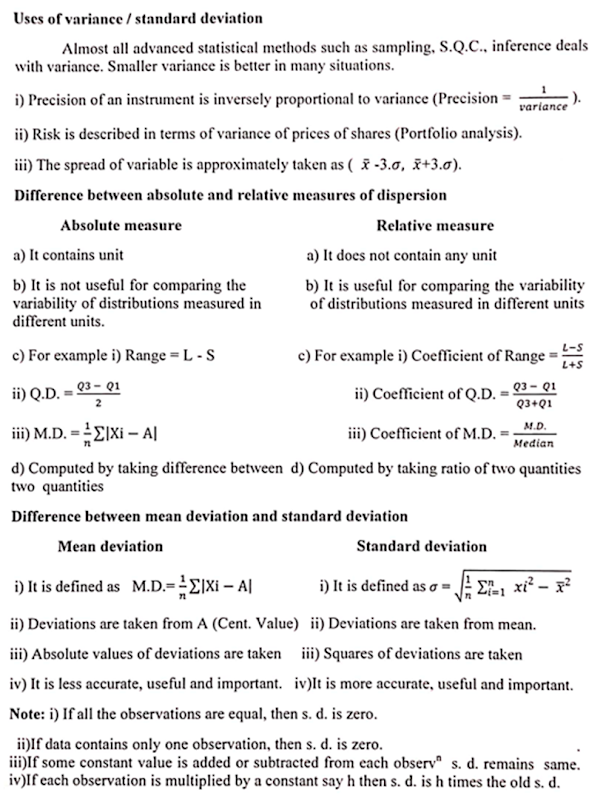Measures of Dispersion : विचलनाची परिमाणे (Dispersion means spreadness, scatteredness, deviation, variation.)
Measures of Dispersion
The a.m. of 100, 100 & 100 and 0, 2& 298 is 100. But in the second case the mean 100 is very much away from the actual values. While in the first case it coincides with the actual values. The actual values in the second case are spread while in the first case not. This aspect of spread or variation of actual values from their representative is called dispersion.
Measure of central tendency gives an idea about the complete set of values. However this idea is not enough to get the clear picture of data. Moreover two or more sets may have the same mean, median and mode but they may be quite different. For example,
|
Set A |
30 |
30 |
30 |
30 |
30 |
|
Set B |
28 |
29 |
30 |
31 |
32 |
|
Set C |
3 |
5 |
30 |
37 |
75 |
All these three sets have mean, median and mode 30. But we observe that the three sets differ remarkably from one another. Thus to have a clear picture of data, one needs to have a measure of dispersion or variability (scatteredness or spreadness) amongst the observations in the set.
We study the dispersion to have an idea
about the homogeneity or the heterogeneity of the distribution. In the above
example, the set A is more homogenous (less dispersed) than the set B & C.
Or we say that set C is more heterogeneous (more dispersed) than the set A or
B.
The more the dispersion, the less is the
reliability of the average and less the dispersion, the more is the reliability
of the average.
Requirements/Characteristics of an ideal (good) Measure of Dispersion
i) It should be rigidly defined i.e. It should have a definite value.
ii)
It should be easy to understand and easy to calculate.
iii)
It should be based on all the observations.
iv)
It should not be affected by extreme values.
v)
It should be suitable for further calculations.
vi)
It should have sampling stability.
Methods of measuring the dispersion:-
The following are the methods of measuring the dispersion.
i) Range
ii)
Quartile deviation or Semi inter quartile range
iii)
Mean deviation (M.D.)
iv)
Standard deviation (S.D.)
Absolute & Relative measures of dispersion:-
Dispersion
measured by any of the above method is expressed in units in which the original
values are measured, it is called absolute measure of dispersion & is
therefore not useful for comparing two distributions measured in two different
units. For that matter, a relative measure of dispersion is calculated which is
a pure number free from units. They are called coefficients of dispersion &
are useful for comparing the variability of two distributions.
Range:-
It is defined as the difference between the largest & the smallest observation in the set. It is denoted by R & is given by,
R= L-S --- (*) , L = Largest observation & S = Smallest observation.
A relative measure of range known as coefficient of range is given as,
Merits:-
It is the simplest measure & can easily be understood.
Demerits:- It is a crude measure of dispersion since it is based on only two extreme values only, ignoring the others. Not suitable for open end classes & for qualitative data.
Uses:- It is used in S.Q.C., in share, in measuring temperature & B.P.
Quartile deviation or Semi inter quartile range:-
The difference between the third quartile & the first quartile is called interquartile range. Symbolically,
ii) It is not affected by extreme values.
iii)
It is suitable for open end classes.
Demerits: i) It is not based on all the observations.
ii) It ignores the first 25 % & last 25% items.
iii) It is not suitable for further calculations.
Mean
deviation:-
It is defined as the average of the absolute deviations taken from the central value, generally the mean or median (am of the deviations with positive sign).
ii)
It is simple to understand & easy to calculate.
iii) It is based on all observations.
Demerits:- i) It is not applicable for qualitative data.
ii) Since algebraic signs of deviations are ignored, it is not applicable for further mathematical treatment.
iii) It is not suitable for open end classes.
Minimal property of Mean Deviation:
Statement : Mean Deviation is minimum, if the deviations are taken from the median.
Standard deviation:-
It is defined as, the positive square root of the arithmetic mean of the squares of the deviations from the mean. In short, s.d. may be defined as 'Root- mean-square- deviation -from- mean'. It is denoted by Greek letter 'σ'. (Sigma).
***













Comments
Post a Comment